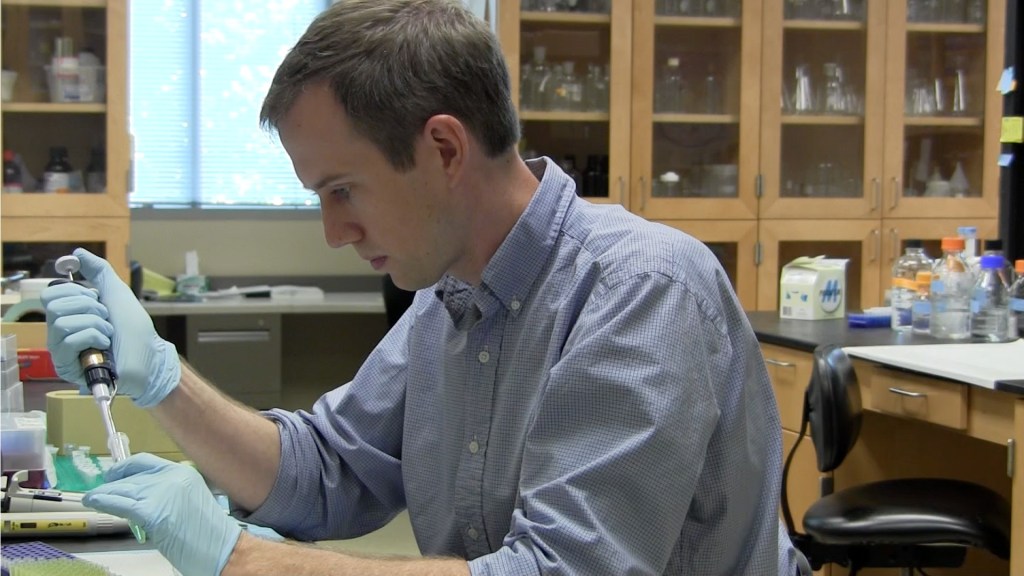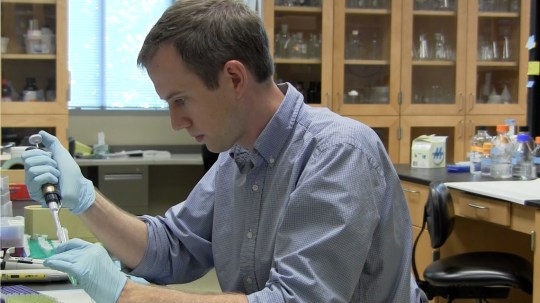Moving new discoveries from the science lab to the doctor’s office can take decades and cost hundreds of millions of dollars. And although it is not possible to eliminate this process, people who straddle the worlds of science and medicine may be able to speed it up.
Consider the task of translating laboratory findings about a deadly cancer into a simple blood test.
Right now, no such test exists for pancreatic cancer, and by the time most cases are detected, it’s too late for effective treatment. As a result, about three-quarters of pancreatic cancer patients die within a year.
Sam Dolezal wants to change this. Dolezal is an M.D.–Ph.D. student who has already spent two years in medical school. When he finishes his doctoral work three years from now, he will have the credentials of both a physician and a lab scientist. Although the number of physician-scientists is growing, only about 500 people in the United States graduate with both degrees each year.
As their ranks increase, so does the potential for speeding the development of better tests and treatments.
People with both degrees “tend to be very focused on what it’s going to take to get from the [lab] bench to the bed,” said Margaret Wagner Dahl, who heads the Georgia BioBusiness Center and helps University of Georgia scientists turn new findings into products.
Physician-scientists, she says, “have had the training to be able to go through that whole continuum.”
Dolezal is one of five future doctors who are also doing Ph.D. research at the University of Georgia. As Athens’ new medical school campus – the Georgia Regents University-University of Georgia (GRU-UGA) medical partnership – enters its fourth year of operation, possibilities exist for more dual-degree students.
They’ve embarked on a long journey, not only in terms of their own education but also their contributions to patient-ready tests and treatments. A new drug, for example, requires about 10 to 15 years to move from lab to doctor’s office. A diagnostic test, like the one Dolezal is working on, takes around three to five years.
Dolezal works in a spacious lab on the top floor of the Complex Carbohydrate Research Center, a brick and wood building nestled among trees like a mountain lodge.
There, he’s part of a team searching for a cancer marker, a molecule that when found in the bloodstream alerts doctors that pancreatic cancer is present.
The lab where Dolezal works is led by Michael Pierce, a professor of biochemistry and molecular biology who directs the UGA Cancer Center. If the researchers can identify such a marker, the next step will be developing a blood test that can be licensed to a pharmaceutical or biotechnology company. After experiments to confirm its accuracy and safety, such a test could enable doctors to diagnose pancreatic cancer at a point when treatment will be more effective.
[youtube]http://www.youtube.com/watch?v=jPf9I3cu3zM&feature=c4-overview&list=UUtg_U8UWdu_fZrvFlVwyXrA[/youtube]Dolezal’s research is shaped by his experiences during medical school. He completed his first two years of med school at GRU’s Medical College of Georgia in Augusta, the parent of the new medical campus in Athens. During his first year, Dolezal met a woman with the type of cancer he now studies in the lab.
“I learned not only how pancreatic cancer was affecting her physically, but also how it was affecting her mentally and emotionally,” Dolezal said. The woman’s only wish was to live six more weeks so she could attend her son’s high school graduation. She met that goal, Dolezal later learned, but died a few weeks later.
“When I’m in the lab, that makes me lean my questions more towards what’s important” for patients, Dolezal said. “Pancreatic cancer doesn’t have a [currently recognized] detection marker, so my project involves trying to find these detection markers.”
While a basic science researcher focuses closely on the biology of the disease, Dolezal’s approach is different.
“He’s looking at it really as a clinician would,” Pierce said. “I can tell he always has in the back of his mind how he can develop his discovery into a treatment or a diagnostic blood test.”
The human factor
In a lab less than two miles away, Joseph Burch is completing the research portion of his two degrees under UGA microbiologist Harry Dailey. He’s also using his two years of medical training to think about how his research could affect patients.
Burch is studying a protein involved the making of heme – an essential part of the oxygen-carrying blood protein hemoglobin. If the protein is defective, toxic levels of chemicals build up in the body and cause one of several diseases commonly known as porphyria. These diseases can cause patients a variety of problems – from seizures to abdominal pain.
“He’s interested in the bigger picture: How this is going to translate into clinical medicine,” Dailey said.
Currently in his second year of doctoral study, Burch is already thinking how what he’s learned in the lab could help design a treatment for porphyria.
After graduation, students like Dolezal and Burch hope to be able to see human maladies from two different perspectives, and to turn laboratory work into relief of human suffering.
“If you got just a Ph.D. and you do biomedical research, you can work in a lab, you can work on animals, but you can’t work on people,” Dailey said. “With a Ph.D. and an M.D., it allows you to do the basic work and to translate it into the clinics.”
Burch is optimistic about his broad education.
“I hope it will make the transition from lab research to drug discovery or treatments more efficient and faster.”
Julianne Wyrick is a freelance science and health writer currently completing the health and medical journalism graduate program at the University of Georgia.


